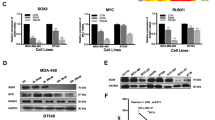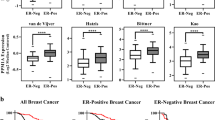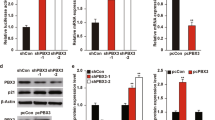Abstract
The FOXO family of Forkhead transcription factors, regulated by the phosphoinositide-3-kinase–Akt pathway, is involved in cell cycle regulation and apoptosis. Strong expression of HER2, a receptor tyrosine kinase oncogene, in cancers has been associated with a poor prognosis. Recently, FOXO4 was shown to regulate the transcription of the cyclin-dependent kinase inhibitor p27 Kip1 gene directly. Also, we have shown that HER2 promotes mitogenic growth and transformation of cancer cells by downregulation of p27 Kip1. Given the fact that FOXO4 mediates p27 transcription, we hypothesize that an Akt phosphorylation mutant of FOXO4 (FOXO4A3), which maintains the activity to transactivate p27 Kip1, may be used as an anticancer agent for HER2-overexpressing cancers. Here, we applied the FOXO4 gene as a novel anticancer agent for HER2-overexpressing cells under the control of a tetracycline (tet)-regulated gene expression system. Overexpression of FOXO4A3 inhibits HER2-activated cell growth. We found that FOXO4A3 inhibited the kinase activity of protein kinase B/Akt and reversed HER2-mediated p27 mislocation in the cytoplasm. FOXO4A3 expression also led to decreased levels of CSN5, a protein involved in p27 degradation. These data suggest that FOXO4A3 also can regulate p27 post-transcriptionally. In addition, we found that FOXO4A3 sensitized cells to apoptosis induced by the chemotherapeutic agent 2-methoxyestradiol. Most significantly for clinical application, FOXO4A3 expression in HER2-overexpressing cells can be regulated in vivo and reduces the tumor volume in a tumor model. These findings indicate the applicability of employing FOXO4 regulation as a therapeutic intervention in HER2-overexpressing cancers.
This is a preview of subscription content, access via your institution
Access options
Subscribe to this journal
Receive 50 print issues and online access
$259.00 per year
only $5.18 per issue
Buy this article
- Purchase on Springer Link
- Instant access to full article PDF
Prices may be subject to local taxes which are calculated during checkout








Similar content being viewed by others
References
Alvarez B, Martinez AC, Burgering BM and Carrera AC . (2001). Nature, 413, 744–747.
Borkhardt A, Repp R, Haas OA, Leis T, Harbott J, Kreuder J, Hammermann J, Henn T and Lampert F . (1997). Oncogene, 14, 195–202.
Brunet A, Bonni A, Zigmond MJ, Lin MZ, Juo P, Hu LS, Anderson MJ, Arden KC, Blenis J and Greenberg ME . (1999). Cell, 96, 857–868.
Burgering BM and Kops GJ . (2002). Trends Biochem. Sci., 27, 352–360.
Chamovitz DA and Segal D . (2001). EMBO Rep., 2, 96–101.
Chen WS, Xu PZ, Gottlob K, Chen ML, Sokol K, Shiyanova T, Roninson I, Weng W, Suzuki R, Tobe K, Kadowaki T and Hay N . (2001). Genes Dev., 15, 2203–2208.
Corral J, Forster A, Thompson S, Lampert F, Kaneko Y, Slater R, Kroes WG, van der Schoot CE, Ludwig WD, Karpas A, Pocock C, Cotter F and Rabbitts TH . (1993). Proc. Natl. Acad. Sci. USA, 90, 8538–8542.
Cross DA, Alessi DR, Cohen P, Andjelkovich M and Hemmings BA . (1995). Nature, 378, 785–789.
Cunningham MA, Zhu Q and Hammond JM . (2004). Mol. Endocrinol., 18, 1756–1767. Epub 2004 Apr 15.
Fujita N, Sato S, Katayama K and Tsuruo T . (2002). J. Biol. Chem., 277, 28706–28713.
Gossen M and Bujard H . (1992). Proc. Natl. Acad. Sci. USA, 89, 5547–5551.
Holbro T, Civenni G and Hynes NE . (2003). Exp. Cell Res., 284, 99–110.
Hu MC, Lee DF, Xia W, Golfman LS, Ou-Yang F, Yang JY, Zou Y, Bao S, Hanada N, Saso H, Kobayashi R and Hung MC . (2004). Cell, 117, 225–237.
Huang P, Feng L, Oldham EA, Keating MJ and Plunkett W . (2000). Nature, 407, 390–395.
Hung SJMaM-C . (1995). Oncol. Rep., 2, 497–503.
Kistner A, Gossen M, Zimmermann F, Jerecic J, Ullmer C, Lubbert H and Bujard H . (1996). Proc. Natl. Acad. Sci. USA, 93, 10933–10938.
Kops GJ, Dansen TB, Polderman PE, Saarloos I, Wirtz KW, Coffer PJ, Huang TT, Bos JL, Medema RH and Burgering BM . (2002a). Nature, 419, 316–321.
Kops GJ, Medema RH, Glassford J, Essers MA, Dijkers PF, Coffer PJ, Lam EW and Burgering BM . (2002b). Mol. Cell. Biol., 22, 2025–2036.
Kouvaraki MA, Rassidakis GZ, Tian L, Kumar R, Kittas C, Claret FX, Lai R, Zhang Q, Sarris AH, McDonnell TJ and Medeiros LJ . (2003). Cancer Res., 63, 2977–2981.
Laronga C, Yang HY, Neal C and Lee MH . (2000). J. Biol. Chem., 275, 23106–23112.
Lee RJ, Albanese C, Fu M, D’Amico M, Lin B, Watanabe G, Haines III GK, Siegel PM, Hung MC, Yarden Y, Horowitz JM, Muller WJ and Pestell RG . (2000). Mol. Cell. Biol., 20, 672–683.
Maira SM, Galetic I, Brazil DP, Kaech S, Ingley E, Thelen M and Hemmings BA . (2001). Science, 294, 374–380.
Medema RH, Kops GJ, Bos JL and Burgering BM . (2000). Nature, 404, 782–787.
Nakamura N, Ramaswamy S, Vazquez F, Signoretti S, Loda M and Sellers WR . (2000). Mol. Cell. Biol., 20, 8969–8982.
Rassidakis GZ, Claret FX, Lai R, Zhang Q, Sarris AH, McDonnell TJ and Medeiros LJ . (2003). Clin. Cancer Res., 9, 1121–1128.
Reynisdottir I, Polyak K, Iavarone A and Massague J . (1995). Genes Dev., 9, 1831–1845.
Sandri M, Sandri C, Gilbert A, Skurk C, Calabria E, Picard A, Walsh K, Schiaffino S, Lecker SH, Goldberg AL, Stitt TN, Drujan D, Clarke BA, Panaro F, Timofeyva Y, Kline WO, Gonzalez M, Yancopoulos GD and Glass DJ . (2004). Cell, 117, 399–412.
Scheidler S, Fredericks WJ, Rauscher III FJ, Barr FG and Vogt PK . (1996). Proc. Natl. Acad. Sci. USA, 93, 9805–9809.
Schmidt M, Fernandez de Mattos S, van der Horst A, Klompmaker R, Kops GJ, Lam EW, Burgering BM and Medema RH . (2002). Mol. Cell. Biol., 22, 7842–7852.
Shin I, Yakes FM, Rojo F, Shin NY, Bakin AV, Baselga J and Arteaga CL . (2002). Nat. Med., 8, 1145–1152.
Slamon DJ, Clark GM, Wong SG, Levin WJ, Ullrich A and McGuire WL . (1987). Science, 235, 177–182.
Tang TT and Lasky LA . (2003). J. Biol. Chem., 21, 21.
Tomoda K, Kubota Y and Kato J . (1999). Nature, 398, 160–165.
Tran H, Brunet A, Grenier JM, Datta SR, Fornace Jr AJ, DiStefano PS, Chiang LW and Greenberg ME . (2002). Science, 296, 530–534.
Tran H, Brunet A, Griffith EC and Greenberg ME . (2003). Sci. STKE, 2003, RE5.
Wei N, Tsuge T, Serino G, Dohmae N, Takio K, Matsui M and Deng XW . (1998). Curr. Biol., 8, 919–922.
Yang HY, Shao R, Hung MC and Lee MH . (2001). Oncogene, 20, 3695–3702.
Yang HY, Wen YY, Chen CH, Lozano G and Lee MH . (2003). Mol. Cell. Biol., 23, 7096–7107.
Yang HY, Zhou BP, Hung MC and Lee MH . (2000). J. Biol. Chem., 275, 24735–24739.
Zhang L and Wang C . (2003). J. Biol. Chem., 278, 27–36.
Zhang Y, Yang HY, Zhang XC, Yang H, Tsai M and Lee MH . (2004). Oncogene, 23, 7132–7143.
Zhou BP, Hu MC, Miller SA, Yu Z, Xia W, Lin SY and Hung MC . (2000). J. Biol. Chem., 275, 8027–8031.
Zhou BP, Liao Y, Spohn B, Lee M-H and Hung M-C . (2001a). Nat. Cell Biol., 3, 245–252.
Zhou BP, Liao Y, Xia W, Zou Y, Spohn B and Hung MC . (2001b). Nat. Cell Biol., 3, 973–982.
Acknowledgements
We thank Drs Burgering, Pestell, and Qiu for valuable reagents, and Mayli Tsai and Ting-fang Che for technical help. This work was supported by a grant from the NIH RO1CA (089266) and by the Susan G Komen Breast Cancer Foundation. M-H Lee is a recipient of the Flemin and Davenport research award and the Susan G Koman Breast Cancer Foundation research award.
Author information
Authors and Affiliations
Corresponding author
Rights and permissions
About this article
Cite this article
Yang, H., Zhao, R., Yang, HY. et al. Constitutively active FOXO4 inhibits Akt activity, regulates p27 Kip1 stability, and suppresses HER2-mediated tumorigenicity. Oncogene 24, 1924–1935 (2005). https://doi.org/10.1038/sj.onc.1208352
Received:
Revised:
Accepted:
Published:
Issue Date:
DOI: https://doi.org/10.1038/sj.onc.1208352
Keywords
This article is cited by
-
Therapeutic strategies targeting FOXO transcription factors
Nature Reviews Drug Discovery (2021)
-
CDK1 dependent phosphorylation of hTERT contributes to cancer progression
Nature Communications (2020)
-
Correlation of constitutive photomorphogenic 1 (COP1) and p27 tumor suppressor protein expression in ovarian cancer
Genes & Genomics (2019)
-
FOXO1 overexpression and loss of pSerine256-FOXO1 expression predicts clinical outcome in esophageal adenocarcinomas
Scientific Reports (2018)
-
MiR-150 promotes cellular metastasis in non-small cell lung cancer by targeting FOXO4
Scientific Reports (2016)



